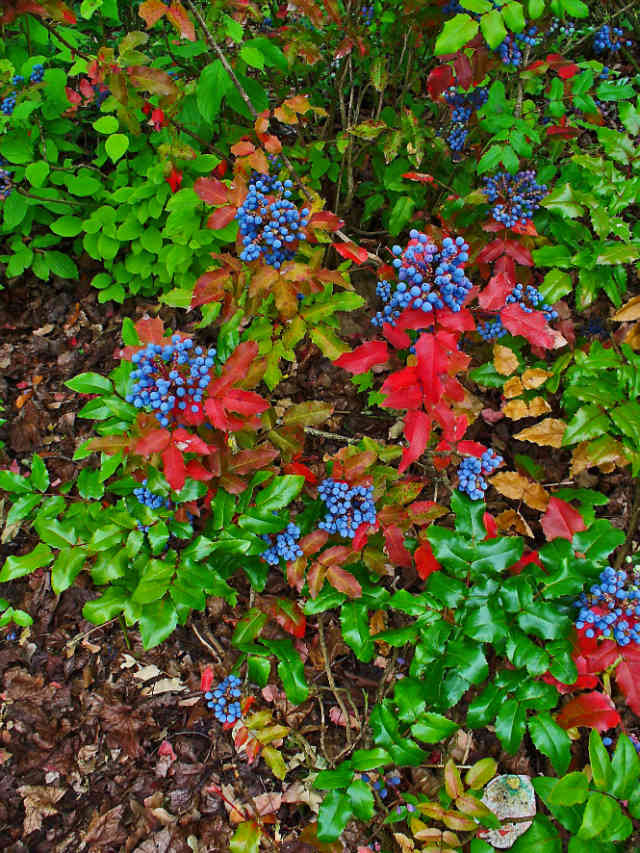
Tall and Low Oregon Grape (Mahonia aquifolium)
Common name(s): Tall or Low Oregon grape
Scientific Name(s): Mahonia aquifolium
Island Hullkemel’em Name(s): suni'ulhp (Downriver/Island); suliyulhp (Upriver)
Family: Berberidaceae
Caution(s): None.
Botanical Description: Tall Oregon grape (M. aquifolium) is a native shrub routinely found in Pacific Northwest forest with small yellow flowers and blue‐black berries. Its roots are long, straight, and yellow inside, and can grow up to 2‐3 in. thick. The inner bark of its roots, stems and leaves contain several alkaloids that have anti‐inflammatory and anti‐bacterial properties which contribute to its medicinal uses. Tall Oregon grape medicinally preferred over low Oregon grape due to its colour and its availability for processing. M. aquifolium has holly-like leaflets with sharp spines along their edges. Tall Oregon grape grows to about 2-5 ft. tall but can grow up to 15 ft. and spreads by underground stems 2-3 in. thick. The plant grows slowly at the beginning but once established the plant will grow quickly to it matured size. Bloom period happens April to May and fruits ripen from September to October.[1]

Current Distribution and Local Habitat(s): As mentioned, Tall Oregon grapes range habitually is found in Pacific Northwest forests ranging from southern BC South through Washington, Oregon, and to California. Tall Oregon grape is usually found at elevations below 4000 ft., and occurs in sunny‐to‐shaded areas and can thrive in rocky areas as opposed to the low Oregon grape. M. aquifolium will tolerate the shaded areas but prospers better in exposed areas. The roots of the plant generally found in nitrogen-medium soils with soil pH reaction and salinity of 5 to 8. After being introduced into Europe in 1822 for ornamental purposes, it took 38 years for M. aquifolium to self-pollinate and exist outside of gardens. Tall Oregon grape is a shrub that is normally situated in drier, more open areas than low Oregon grape. The plant is often found near the sides of highways along with forests and garden beds.[2]
Ethnobotanical Application(s): The juices from the berries have a lot of natural pectin and is typically made into jelly or wine, by itself or in combination with other berries such as salal. The roots of M. aquifolium are bright yellow and were often used for making dye, primarily for baskets. It is said that the First Nations peoples of British Columbia used the berries of the plant as a blood purifier because it is believed to be good for the blood as well as cleanses the liver. Furthermore, the roots were made into a powerful tea to help the reproductive system and help to deliver the placenta. Root tea has also been noted as being used to help treat gonorrhoea and syphilis. Oregon grape root is an anti-inflammatory, antibacterial, antioxidant, Cholagogue, hepatic, and laxative. The bark has antimicrobial properties which kill micro-organism and inhibit their growth which makes it beneficial for healing wounds and abrasions.[3]
Uvic Campus Location(s): Oregon grape shrubs can be found throughout the University of Victoria campus, more specifically in the following areas: Haro woods, Finnerty Ravine, South woods, Cunningham woods, Native Plant
Figure Reference(s):
Figure 1: http://www.herbalremediesadvice.org/oregon-grape-herb.html
Figure 2: https://lambethbandofsolidarity.wordpress.com
[1] Native Plants PNW. Tall Oregon Grape, Mahonia aquifolium. Accessed January 09, 2017. http://nativeplantspnw.com/tall-oregon-grape-mahonia-aquifolium/.
[2] Ibid.
[3] BRIT. Native American Ethnobotany Database. http://naeb.brit.org/uses/search/?string=Oregon%2Bgrape.
